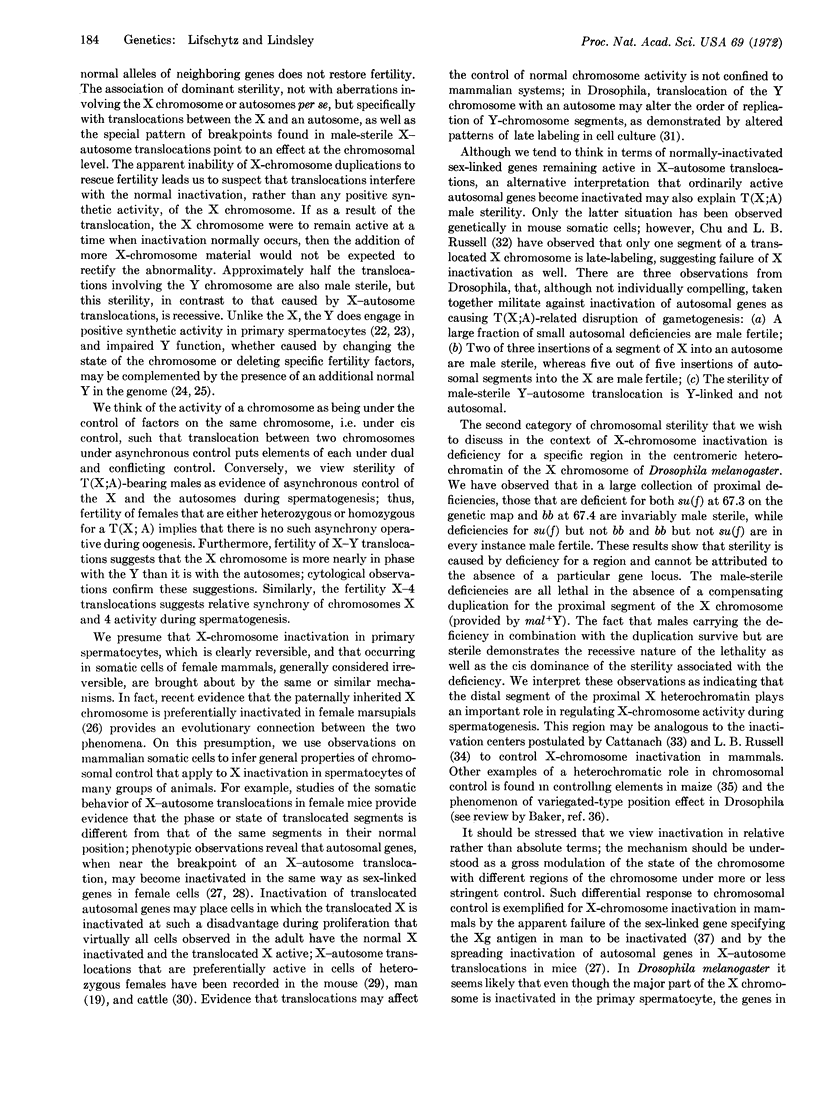Abstract
Inactivation of the single X chromosome in the primary spermatocytes of species with heterogametic males is postulated as a basic control mechanism on the chromosomal level that is required for normal spermatogenesis. This view is supported by (a) cytological observations of X-chromosome allocycly in the primary spermatocytes of all male-heterogametic organisms that were adequately examined, (b) autoradiographic evidence of early cessation of transcription by the X chromosome in the mouse and three species of grasshopper, and (c) the male sterility of animals with certain X-chromosome rearrangements that cannot be attributed to misfunction of specific genes. X-chromosome inactivation during spermatogenesis is proposed as the ideal system for studies of genetic control at the chromosomal level.
Keywords: Drosophila, allocycly, chromosome evolution, male sterility, dosage compensation
Full text
PDF




Images in this article
Selected References
These references are in PubMed. This may not be the complete list of references from this article.
- BROWN S. W., NUR U. HETEROCHROMATIC CHROMOSOMES IN THE COCCIDS. Science. 1964 Jul 10;145(3628):130–136. doi: 10.1126/science.145.3628.130. [DOI] [PubMed] [Google Scholar]
- Baker W. K. Position-effect variegation. Adv Genet. 1968;14:133–169. [PubMed] [Google Scholar]
- Bridges C. B. TRIPLOID INTERSEXES IN DROSOPHILA MELANOGASTER. Science. 1921 Sep 16;54(1394):252–254. doi: 10.1126/science.54.1394.252. [DOI] [PubMed] [Google Scholar]
- Brosseau G E. Genetic Analysis of the Male Fertility Factors on the Y Chromosome of Drosophila Melanogaster. Genetics. 1960 Mar;45(3):257–274. doi: 10.1093/genetics/45.3.257. [DOI] [PMC free article] [PubMed] [Google Scholar]
- CATTANACH B. M. A chemically-induced variegated-type position effect in the mouse. Z Vererbungsl. 1961;92:165–182. doi: 10.1007/BF00890283. [DOI] [PubMed] [Google Scholar]
- Cattanach B. M., Pollard C. E., Perez J. N. Controlling elements in the mouse X-chromosome. I. Interaction with the X-linked genes. Genet Res. 1969 Dec;14(3):223–235. doi: 10.1017/s0016672300002068. [DOI] [PubMed] [Google Scholar]
- Cooper D. W. Directed genetic change model for X chromosome inactivation in eutherian mammals. Nature. 1971 Apr 2;230(5292):292–294. doi: 10.1038/230292a0. [DOI] [PubMed] [Google Scholar]
- Gustavsson I., Fraccaro M., Tiepolo L., Lindsten J. Presumptive x-autosome translocation in a cow: preferential inactivation of the normal x chromosome. Nature. 1968 Apr 13;218(5137):183–184. doi: 10.1038/218183a0. [DOI] [PubMed] [Google Scholar]
- Halfer C., Tiepolo L., Barigozzi C., Fraccaro M. Timing of DNA replication of translocated Y chromosome sections in somatic cells of Drosophila melanogaster. Chromosoma. 1969;27(4):395–408. doi: 10.1007/BF00325678. [DOI] [PubMed] [Google Scholar]
- Hennig W. Untersuchungen zur Struktur und Funktion des Lampenbürsten-Y-Chromosoms in der Spermatogenese von Drosophila. Chromosoma. 1967;22(3):294–357. doi: 10.1007/BF00319879. [DOI] [PubMed] [Google Scholar]
- Kofman-Alfaro S., Chandley A. C. Meiosis in the male mouse. An autoradiographic investigation. Chromosoma. 1970;31(4):404–420. doi: 10.1007/BF00285832. [DOI] [PubMed] [Google Scholar]
- LIN T. P. The chromosomal cycle in Parascaris equorum (Ascaris megalocephala); oogenesis and diminution. Chromosoma. 1954;6(3):175–198. doi: 10.1007/BF01259939. [DOI] [PubMed] [Google Scholar]
- LYON M. F. Gene action in the X-chromosome of the mouse (Mus musculus L.). Nature. 1961 Apr 22;190:372–373. doi: 10.1038/190372a0. [DOI] [PubMed] [Google Scholar]
- Lindsley D L, Edington C W, Von Halle E S. Sex-Linked Recessive Lethals in Drosophila Whose Expression Is Suppressed by the Y Chromosome. Genetics. 1960 Dec;45(12):1649–1670. doi: 10.1093/genetics/45.12.1649. [DOI] [PMC free article] [PubMed] [Google Scholar]
- MEYER G. F., HESS O., BEERMANN W. [Phase specific function structure in spermatocyte nuclei of Drosophila melanogaster and their dependence of Y chromosomes]. Chromosoma. 1961;12:676–716. doi: 10.1007/BF00328946. [DOI] [PubMed] [Google Scholar]
- McCLINTOCK B. Chromosome organization and genic expression. Cold Spring Harb Symp Quant Biol. 1951;16:13–47. doi: 10.1101/sqb.1951.016.01.004. [DOI] [PubMed] [Google Scholar]
- Monesi V. Synthetic activities during spermatogenesis in the mouse RNA and protein. Exp Cell Res. 1965 Aug;39(1):197–224. doi: 10.1016/0014-4827(65)90023-6. [DOI] [PubMed] [Google Scholar]
- Nicoletti B, Lindsley D L. Translocations between the X and the Y Chromosomes of Drosophila Melanogaster. Genetics. 1960 Dec;45(12):1705–1722. doi: 10.1093/genetics/45.12.1705. [DOI] [PMC free article] [PubMed] [Google Scholar]
- OHNO S., JAINCHILL J., STENIUS C. THE CREEPING VOLE (MICROTUS OREGONI) AS A GONOSOMIC MOSAIC. I. THE OY/XY CONSTITUTION OF THE MALE. Cytogenetics. 1963;2:232–239. doi: 10.1159/000129781. [DOI] [PubMed] [Google Scholar]
- OHNO S., LYON M. F. CYTOLOGICAL STUDY OF SEARLE'S X-AUTOSOME TRANSLOCATION IN MUS MUSCULUS. Chromosoma. 1965 Jan 30;16:90–100. doi: 10.1007/BF00320564. [DOI] [PubMed] [Google Scholar]
- Odartchenko N., Pavillard M. Late DNA replication in male mouse meiotic chromosomes. Science. 1970 Feb 20;167(3921):1133–1134. doi: 10.1126/science.167.3921.1133. [DOI] [PubMed] [Google Scholar]
- Rieffel S. M., Crouse H. V. The elimination and differentiation of chromosomes in the germ line of sciara. Chromosoma. 1966;19(3):231–276. doi: 10.1007/BF00326917. [DOI] [PubMed] [Google Scholar]
- Ritossa F. M., Atwood K. C., Spiegelman S. A molecular explanation of the bobbed mutants of Drosophila as partial deficiencies of "ribosomal" DNA. Genetics. 1966 Sep;54(3):819–834. doi: 10.1093/genetics/54.3.819. [DOI] [PMC free article] [PubMed] [Google Scholar]
- Russell L. B., Montgomery C. S. Comparative studies on X-autosome translocations in the mouse. I. Origin, viability, fertility, and weight of five T(X;1)'S. Genetics. 1969 Sep;63(1):103–120. doi: 10.1093/genetics/63.1.103. [DOI] [PMC free article] [PubMed] [Google Scholar]
- Russell L. B., Montgomery C. S. Comparative studies on X-autosome translocations in the mouse. I. Origin, viability, fertility, and weight of five T(X;1)'S. Genetics. 1969 Sep;63(1):103–120. doi: 10.1093/genetics/63.1.103. [DOI] [PMC free article] [PubMed] [Google Scholar]
- Russell L. B., Montgomery C. S. Comparative studies on X-autosome translocations in the mouse. II. Inactivation of autosomal loci, segregation, and mapping of autosomal breakpoints in five T (X;1) S. Genetics. 1970 Feb;64(2):281–312. doi: 10.1093/genetics/64.2.281. [DOI] [PMC free article] [PubMed] [Google Scholar]
- Searle A. G., Evans E. P., Ford C. E., West B. J. Studies on the induction of translocations in mouse spermatogonia. I. The effect of dose-rate. Mutat Res. 1968 Nov-Dec;6(3):427–436. doi: 10.1016/0027-5107(68)90060-2. [DOI] [PubMed] [Google Scholar]
- Sturtevant A H, Novitski E. The Homologies of the Chromosome Elements in the Genus Drosophila. Genetics. 1941 Sep;26(5):517–541. doi: 10.1093/genetics/26.5.517. [DOI] [PMC free article] [PubMed] [Google Scholar]



